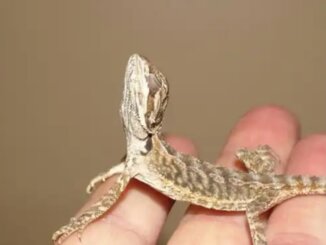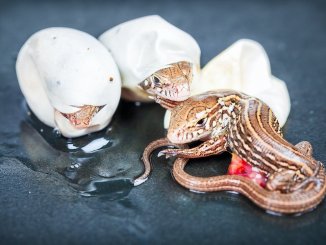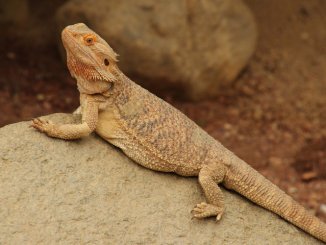Does my bearded dragon have tail rot? This is among the most commonly asked questions by many new bearded dragon parents.
While many understand bearded dragon tail rot is a disease, few know how dangerous this infection is when left untreated.
If you suspect your bearded dragon has tail rot, check out the guide below. We cover everything you need to know about tail rot including its causes and how to treat it.
What Is Tail Rot?
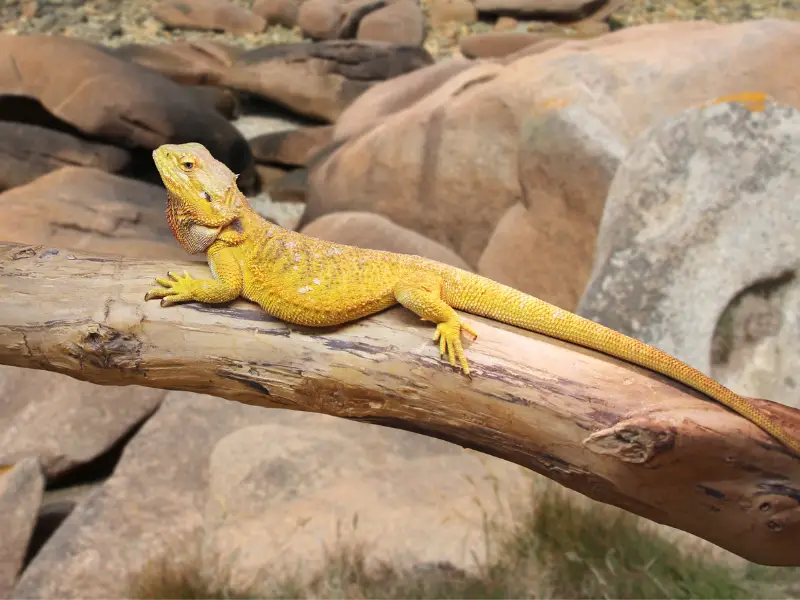
Tail rot is one of the most common diseases that affect reptiles, including bearded dragons.
It’s a condition where your bearded dragon’s tail darkens (turns purple, black, or blue) and rots due to an unhealthy blood flow.
Bearded dragon tail rot is a serious condition you shouldn’t take lightly. As the disease spreads, it’ll cause rapid cell death, and loss of nerve function and your pet’s tail will fall off.
And unlike other lizards, bearded dragons can’t grow a new tail.
If you don’t take immediate medical action, the disease will spread to other organs causing organ failure and other health diseases, eventually leading to the death of your beloved pet.
Something else to remember is that tail rot affects all bearded dragons of all ages, sex, size, and species. However, injured, stressed, or sick bearded dragons are at a higher risk.
What Causes Bearded Dragon Tail Rot?
There are several things that can cause bearded dragon tail rot, two of the main causes being trauma and an improper diet.
Trauma
One of the main causes of tail rot is trauma (injuries).
Common trauma causes include bites from other bearded dragons (baby bearded dragons often live together in the same habitat), bites from prey (insects), or incomplete shedding that may cut off blood flow to the tail.
When injured, your bearded dragon’s tail cracks, leaving an open wound. Tail rot begins when harmful bacteria in your bearded dragon’s habitat infect your pet through this wound.
Improper Diet And Poor Nutrition
A proper diet and good nutrition will improve your bearded dragon’s immune system. So, with an improper diet, your bearded dragon will not be able to fight off bacteria and infections.
Pay close attention to the calcium levels in your pet’s food. The amount of calcium in your bearded dragon’s diet affects its size since it influences cartilage growth and the formation of strong bones.
Low calcium levels weaken your pet’s bone structure, leaving your reptile’s tail vulnerable to infections.
Therefore, it’s best to avoid feeding your lizard vegetables in the cruciferous family (cauliflower, broccoli, etc.) since they bind calcium to reptiles.
Other Causes
While the above two are the main causes of bearded dragon tail rot, there are other causes of this condition that you should know about.
Poor Lighting
Vitamin D is known to aid in developing strong bones and body structures in living beings. Since the best source of Vitamin D is UVB rays in sunlight, you need to make sure your beardie’s habitat has access to sunlight.
Failure to provide good access to UVB rays increases the risk of infections like tail rot and bone diseases in your bearded dragon.
If your bearded dragon’s habitat can’t access sunlight, installing UVB lights in the tank is your best bet.
Ensure you leave the lights on for about 12 to 14 hours so your pet can absorb a healthy amount of Vitamin D.
Poor Tank Hygiene
Improper care of your bearded dragon’s enclosure creates a good breeding ground for harmful bacteria.
Leftover food, high humidity, fecal matter, and old substrate promote the rapid growth of harmful bacteria.
When bacteria multiply to unsafe levels, it becomes nearly impossible for you to protect your beardie’s health, especially if your pet is sick, injured, or stressed.
When you regularly clean the enclosure and ensure your bearded dragon’s substrate is clean, the growth of the bacteria greatly decreases.
Embolisms
Embolisms in beardies arise when the blood supply to their tails is cut off, which can increase the risk of getting tail rot.
The main cause of embolisms is improper handling by pet owners and improper diets. In other cases, getting trapped in tight spaces can cause embolism.
As its parent, you must learn how to handle your bearded dragon properly. Don’t pick up your pet by its tail, as this increases the chances of embolism. Instead, handle your bearded dragon by supporting its entire body, including the tail.
How To Identify Tail Rot In Bearded Dragons
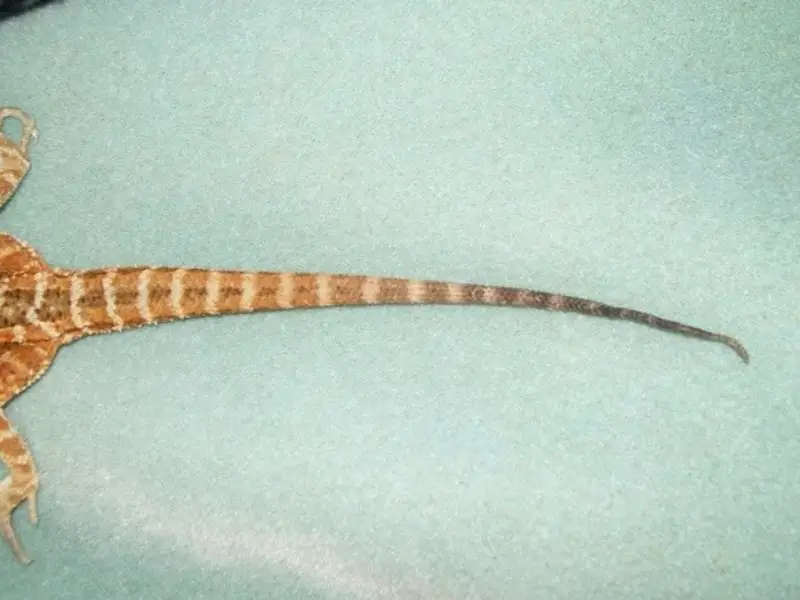
Identifying tail rot in its early stages is difficult for new bearded dragon owners. However, that doesn’t mean you can’t figure it out early on before your beloved pet starts suffering.
Below are the signs and symptoms that’ll help you know if your bearded dragon has tail rot.
Physical Changes
Let’s start with the physical changes caused by tail rot. They’re the most effective way of identifying tail rot in bearded dragons.
Tail Color Change
Tail discoloration is the beginning of tail rot and starts from the tip. As necrosis (death of body cells and tissues) starts to set in, the color of the infected skin turns light gray.
At this stage, it’s nearly impossible to identify the disease because this discoloration is almost similar to the color change that occurs when bearded dragons shed their skin.
However, the infected skin grows darker as the infection spreads, and you might notice rotting scales falling off.
Dry Scales
The more the infection takes root, the less blood flows to the tail. This results in your beardie’s tail scales becoming dry and brittle.
Dry scales are often crumbly and dull and easily peel off when you touch the tail.
On the other hand, healthy scales appear colorful, firm, and glossy.
Tail Deformity
As your bearded dragon’s rail continues to rot, it’ll start changing shape. You’ll notice the tail becoming thin, uneven, and bony. In extreme cases, sharp bends might develop.
This appearance isn’t normal because the tails in healthy bearded dragons are firm, wider, straight, thicker, and narrow evenly towards the tip.
Tail Loss
When the tail is completely falling off, it means it’s now completely dead.
Tail loss is the worst-case scenario because if the tail rot is at this stage, your bearded dragon has suffered a lot. It also means that your beardie is at a greater risk of losing its life.
So, we advise you to contact your veterinarian and get your bearded dragon immediate help as soon as you start to notice any symptoms.
Behavioral Changes
Sudden behavioral changes in your bearded dragon aren’t normal. They’re usually a sign of sickness. Below are some behavioral changes typically associated with bearded dragon tail rot.
Irritability
Your infected beardie becomes impatient and irritable and shows high levels of aggressiveness. You’ll notice that it’s often hissing and trying to bite back when touched.
This is usually a sign of pain and distress. In some cases, your dragon’s beard turns black due to stress.
Discomfort When Touched
Tail rot is painful for bearded dragons. If you notice your beardie flinching or moving away when you or something touches its tail, this is a sign that something is wrong.
Withdrawal And Reclusive Behavior
Bearded dragons are social and friendly with human beings. They’re reptiles with one of the highest tolerance to human touch.
Therefore, if your bearded dragon hides in its tank for longer periods than usual, conduct a full physical check to look for tail rot.
Loss Of Appetite
A sudden decrease in food intake is the first behavioral change that shows that your bearded dragon isn’t okay.
When you notice this, take your pet for a vet examination immediately. However, be careful not to confuse bearded dragon brumation (they don’t eat during brumation) with bearded dragon tail rot.
How To Treat Bearded Dragon Tail Rot
We can’t emphasize enough how serious a condition tail rot is. If your bearded dragon has tail rot, the best action is to contact a veterinarian as soon as possible!
Tail rot progresses fast, and immediate medical care increases your chances of saving your beloved beardie.
While we advise you to visit a vet if you suspect tail rot infection, there are home remedies we recommend if you identify the disease in its very early stages.
Home Remedy Treatments For Bearded Dragon Tail Rot
Below are home remedies that bearded dragon owners have had some success with when treating tail rot.
Betadine And Water Soak
This is one of the most common home remedies for treating bearded dragon tail rot. Here’s how you should do it.
- Start by cleaning the infected tail part with warm water
- Mix one part Betadine (iodine) with three parts warm water and stir the mixture until it resembles dark tea
- Immerse the infected tail part completely in the mixture and let it soak for 5 minutes
- Dry the tail with clean paper towels or cotton
- Now apply Neosporin on the infected part (use Neosporin without pain relievers – they’re fatal to reptiles)
- Repeat the treatment twice a day for an entire week and be gentle
If you don’t see any improvements after a week, it’s time to visit a reptile vet.
Vinegar Treatment
Vinegar has microbial properties, making it an excellent solution to treat bacterial infections. This treatment process is quite similar to the Betadine treatment.
Mix one part white vinegar with two parts warm water and stir well. Soak the infected part of your beardie’s tail and do this thrice a day.
When using apple cider vinegar, mix a quarter cup of apple cider vinegar with two parts warm water and repeat the above process.
Vet Treatments For Bearded Dragon Tail Rot
When you don’t see immediate improvements after using the above home remedy treatments for a week, it’s time to have your beardie checked on by a reptile veterinarian.
Vets have the knowledge, skills, and equipment to conduct a proper physical exam and other diagnostic tests to check the levels of bacteria and organ damage.
Depending on the severity of the tail rot, your vet will offer two treatment options, tail amputation or antibiotics and topical medications.
Antibiotics And Topical Medications
If your beardie’s tail rot is in its early stages, your vet will likely start with antibiotics.
The antibiotics prescribed by your vet are several times stronger than home remedies and other commercial medication, and they’re also specially developed to be safe for reptiles.
In most cases, your bearded dragon has to eat the medication in its powdered form to get better. However, there are topical medications you can apply on the infected tail part.
The cost of antibiotic treatments depends on treatment duration and medication type. On average, the treatment costs around $50 to $70, but the price can rise or decrease depending on your vet.
Tail Amputation
Tail amputation is only used as a last resort to save your bearded dragon’s life. In many cases, home remedies and antibiotics rarely work on moderate to severe tail rot infections.
So, to save your pet’s life, removing part or the entire tail is usually the only solution with high survival rates.
During the procedure, your vet first X-rays your beardie to determine the length of the tail to cut out. Next, they sedate your pet and conduct the surgery.
Afterward, they’ll prescribe painkillers, antibiotics, and husbandry tips to help your bearded dragon’s recovery.
On average, the costs of bearded dragon tail rot surgery are between $100 to $300, including medication. While this may seem expensive, the procedure is important since it’ll save your beloved pet’s life.
How To Prevent Bearded Dragon Tail Rot
To save your bearded dragon from unnecessary pain and to save yourself some money, it’s better for you to learn how to prevent bearded dragon tail rot. Here are our top tips for prevention:
Buy Your Bearded Dragon From The Best Breeders
Did you know that many pet stores sell bearded dragons already suffering from tail rot?
Many pet stores house their young bearded dragons together. Therefore, they regularly get aggressive and bite each other, leaving some at risk of getting infected with tail rot.
Despite knowing that their bearded dragons are sick, many pet owners knowingly sell you the pet without telling you to maximize their profits.
So, before buying a bearded breeder, conduct research on the most reputable breeders in your area.
Here is an article with a list of some of the best breeders in the U.S.: Best Bearded Dragon Breeders.
Provide A Safe Enclosure
Healthy adult bearded dragons have a large body size. So, make sure your bearded dragon’s terrarium is adequate enough for proper movement.
Bearded dragons aren’t particularly social with each other. If you have more than one bearded dragon, arrange to house each pet in its own enclosure. Protecting bearded dragons from each other is one of the most effective ways of preventing tail rot.
Ensure that there’s nothing in the enclosure that can cause injury to your pet. This also includes the fixtures you’ll add in the enclosure to mimic their natural environment.
You also need to ensure the enclosure has proper living conditions. This means humidity, temperature, lighting, and heating must be at optimum levels.
Proper Cleaning Of The Enclosure
An enclosure filled with poop, rotting food, and old substrate will increase the number of harmful bacteria. You must clean your bearded dragon’s tank regularly!
There are different types of bearded dragon substrate choices. Some only require cleaning, and some need replacing every two weeks.
So, ensure the substrate you choose is one you can properly maintain.
Aside from cleaning or replacing the substrate, we also recommend washing the enclosure every time you’re replacing or cleaning your substrate.
Use a mixture of one-part bleach and 32 parts hot water. This will kill a large percentage of harmful bacteria.
Provide A Proper Diet
A healthy bearded dragon is at a lower risk of suffering from tail rot. Ensure the food you feed your pet has a proper distribution of vitamins and minerals to maintain a healthy immune system.
Since bearded dragons are omnivorous, you should ensure your pet has a healthy mix of vegetables, fruit, and animal protein.
For good bone growth and development, calcium supplements will come in handy.
If possible, we recommend you provide your bearded dragon with the opportunity to hunt down its food.
Aside from a delicious meal, your pet will play, exercise, and learn to act on its natural instincts.
In Summary
Protecting your bearded dragon’s life from tail rot infection comes down to how you take care of your pet.
So, whether you’re an experienced or newbie bearded dragon owner, carefully follow through with the tips we’ve provided you above to help you avoid or treat tail rot.
If you’d like more information on how to take care of your bearded dragon, here’s a definitive guide on how to feed your bearded dragon.
This article teaches you the best food to feed your pet, and you’ll have access to a free feeding guide.

